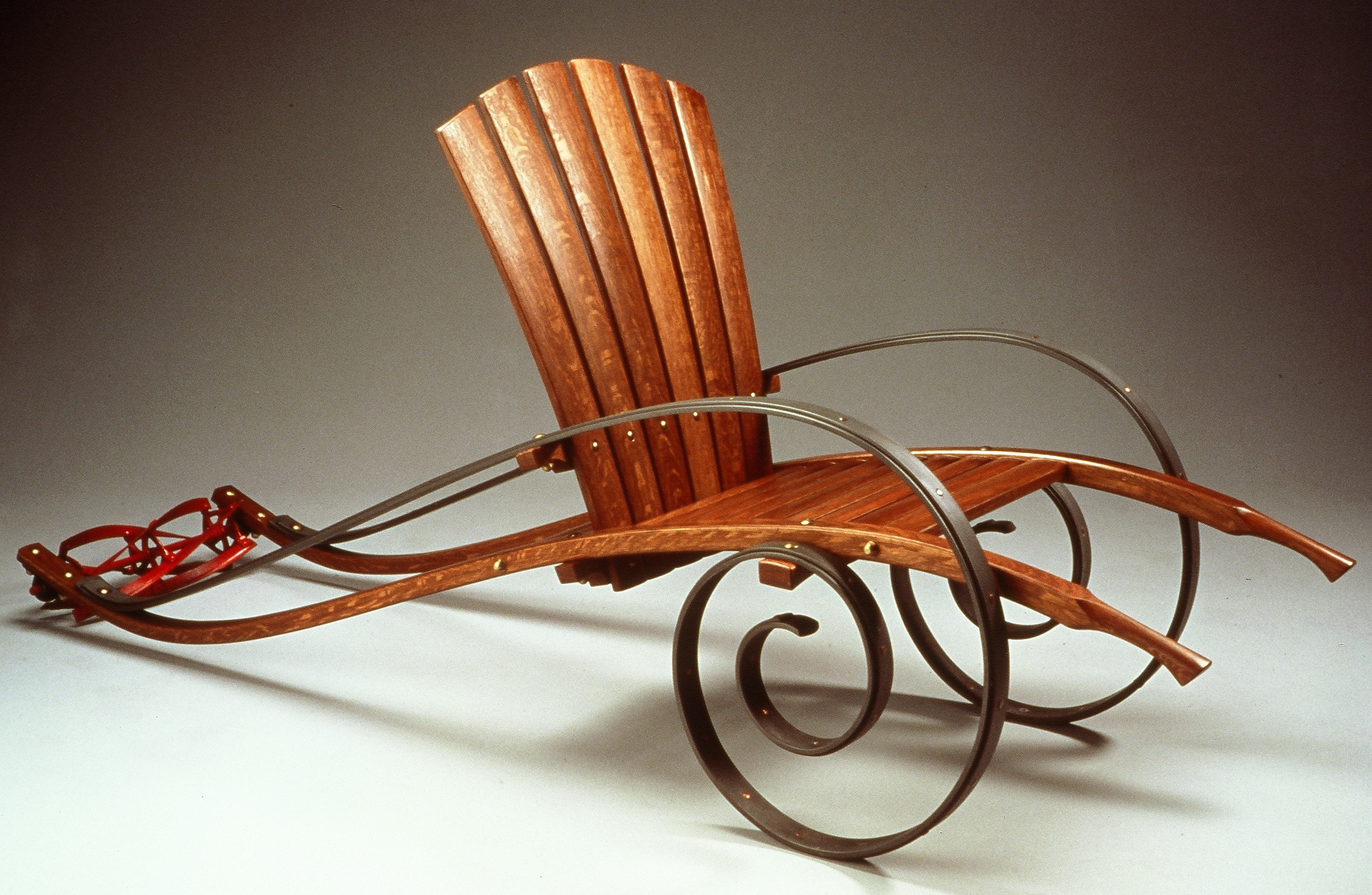Each year, the staff at the William Benton Museum of Art faces a creative challenge in determining how to curate an exhibition related to the annual UConn Reads book selection. The books have included some addressing topical issues, such as Sacred Ground: Pluralism, Prejudice, and the Promise of America, by Eboo Patel in 2016, and others considered classic literature, like F. Scott Fitzgerald’s The Great Gatsby in 2012.
The book selected for 2018-2019 was George R.R. Martin’s A Game of Thrones, the first novel in a multi-volume series titled, A Song of Fire and Ice, which gained a wider audience through HBO’s highly popular televised series that concludes later this year.
“When I saw the book selection, I started getting lost in the concept of fantasy art,” says Nancy Stula, executive director of the Benton and curator for the exhibit. “I toyed around with having a costume show, because Game of Thrones costumes are spectacular. In the end, the idea of the chairs kept resonating, and I decided to explore furniture as art.”
The Benton’s exploration of chairs takes a modern view of chairs designed in the 20th and 21st centuries in “Game of Thrones: An Exhibition of Contemporary Art Furniture,” which opened last week and continues through July 31.
Central to this exhibition is the idea that design aesthetics and function can be integrated into one object. — Nancy Stula
“Game of Thrones” features examples of art chairs created by some of the key artists and makers of contemporary art furniture: John Dunnigan, Jim Cole, Terence Main, Mitch Ryerson, Lothar Windels, Estudio Campana, Dale Broholm, and Wendell Castle.
“Chairs are democratic in that everyone knows what chairs are, everyone sits in chairs daily, and everyone likely owns at least one chair,” says Nancy Stula, executive director of the Benton and curator for the exhibit. “It can be a challenge for some of our audience to accept a chair’s status as art. It is our goal to introduce the museum-going public and the Benton’s student audience to the decorative arts as fine art, and to the concept that the chairs on view are a form of sculpture. Central to this exhibition is the idea that design aesthetics and function can be integrated into one object.”
Stula says one of her objectives with the exhibition is to illustrate that decorative arts – which include textiles, silver, ceramics/glass, and furniture – are also fine art. Decorative arts are defined as the design of objects that are both functional and beautifully designed.
The Iron Throne in “Game of Thrones” is an imposing seat created from the swords of defeated rulers (allegedly 1,000 swords, but the actual number of swords is 200) melted by the fiery breath of the dragon, Balerion the Black Dread, and shaped into a seat. But the concept of a chair literally representing a seat of power was a gradual process, according to Witold Rybczynski, an architect, professor emeritus of urbanism at the University of Pennsylvania and author of a book on the history of chairs titled Now I Sit Me Down: From Klismos to Plastic Chair, A Natural History (2016).
“Attaching status to sitting has more to do with the nature of a society than with the chair itself,” Rybczynski says in an email interview. “You can divide early civilizations into chair-sitters and floor-sitters (or, in the case of ancient Egypt, both). China was the unique case of a floor-sitting culture that voluntarily shifted to chair-sitting. Status is sometimes associated with sitting, especially in the case of thrones, but not always. For example, Egyptians used stools while working, but important people are sometimes shown kneeling or squatting, as well as sitting. In ancient Greece, we have representations of klismos chairs occupied by men and women, musicians and philosophers, so it seems to have been a democratic device.”
Rybczynski notes that chairs, such as a classic Windsor chair or the ancient klismos chair – which has a curved backrest and tapered, outcurved legs – can have sculptural qualities.
“Chairs are like buildings – they can be made with artistry but this is always tied to a practical function,” he says. “It is this particular combination of beauty and utility that is the peculiar attribute of a ‘beautiful’ chair. If you disconnect the two, you don’t gain anything, and you lose something precious. Chairs, like any domestic object, can have aesthetic appeal: the pattern of the fabric, the shape of a leg, the workmanship, the texture of wood. And furniture is always a part of the overall decor of a home, which always has an aesthetic side.”
The Benton exhibition includes chairs made of wood, bronze, gilded fiberglass, stainless steel, and found objects, including:
• “Ode to King Bee,” c. 1990 (bronze), an armchair by Jim Cole;
• “Armchair Gardener,” 2000 (fumed oak, aluminum found objects, copper, bronze) by Mitch Ryerson;
• “Cake Stool,” 2008 (stuffed animals hand sewn on canvas cover over brushed stainless steel structure) by Estudio Campana;
• “Wing Chair,” 2019 (birch plywood, crackle milk paint, polyurethane finish) by Dale Broholm.
Watch the exhibition being installed:
There are interactive components to the exhibit. Visitors can use the Guide By Cell exhibit tour to hear Charlotte MacGregor ’17 (SFA), a “Game of Thrones” fan who served as an intern at the Benton while earning her degree in art history, offer her thoughts on matching each chair with a character from the series. There’s a large whiteboard on a wall, where visitors can attach a post-it note offering their thoughts on McGregor’s comments as well as their own. And there’s also a room off the main gallery area, where a “Game of Thrones” backdrop is set up for visitors to take selfies.
There will be an Artist Talk on Contemporary Art Furniture by John Dunnigan, artist and professor of furniture design at Rhode Island School of Design, on April 26. For more information go to the Benton Museum website.
Also on display is the Balcony Study Gallery exhibition, “Counterproof Press: Collaborations,” samples of the collaborative studio projects facilitated by UConn’s Counterproof Press, including broadsides from the Wallace Stevens Poetry Program, student-driven projects, and work by visiting artists. Counterproof Press is a hub for printmaking, illustration, design, book arts, and creative writing at the University of Connecticut. For more information, visit the press’ website.



